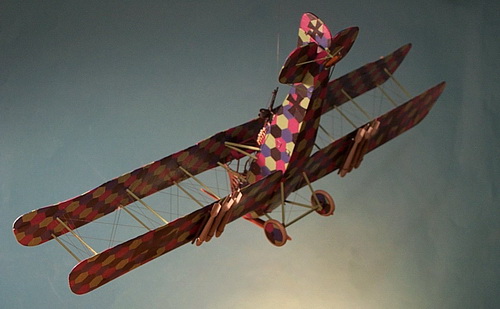
AEG N. I was a long-span version of the AEG C. IV modified to carry more bombs, and this view clearly shows the key N. I recognition features. First, the N. I had a long wing with 3-bay bracing compared to the shorter, 2-bay wings of the C. IV. Next, the triangular bracing truss above the upper wing center section was required to strengthen the longer N. I wing against bending so it could pass the required load test. Unlike its daylight predecessor the AEG C. IV, the N. I did not have a fixed machine gun for the pilot; the observer’s gun was thought sufficient for both strafing and defending the aircraft at night. The high exhaust stack directed the noise and flames away from the aircraft, which was important to maintain the pilot’s night vision. Typical AEG sprayed camouflage on the upper surfaces is evident.
Like the General Electric Company in the United States, the Allgemeine Elektrizitäts-Gesellschaft was one of the more powerful and progressive technology-based companies in Germany. As part of its forward thinking, AEG established a Flugtechnische Abteilung (aero-technical department) at Hennigsdorf (north of Berlin) in 1910 directed by Oberingenieur Paul Stumpf, who pioneered the use of autogeneous-welded steel tubing for aircraft, an advanced structural technology at a time when most airplanes were made of wood. All subsequent AEG aircraft used this technology.
New assembly shops were opened in July 1915 in Nieder-Neuendorf to become the AEG Flugzeugfabrik led by Direktor Bassler. In the winter of 1915-1916, flight tests of an improved two-seat reconnaissance biplane, known as the AEG C. IV, were satisfactorily completed. Ordered in quantity, the C. IV was praised as a fast, rugged aircraft that stood up well during combat operations.
AEG responded to the N-type specification by modifying their successful AEG C. IV to lift a 300 kg bomb load by increasing the wingspan 2.24 meters (7.3 ft); changing the wing from a two-bay to a three-bay design. In September 1916, the AEG C. IVn prototype completed its initial flight trials, proving that it was stable and easy to fly, important criteria for night flying. AEG received a production order in December 1916 for 100 AEG C. IVn night bombers.
The first AEG C. IVn production example (C. 9323/16) was dispatched to Adlershof in April 1917 for type-testing. The C. IVn wing failed repeated load tests and it was not until 7 June 1917 that sufficient bending strength was achieved by the installation of triangular reinforcing trusses over both the forward and aft center section spars. This solution, structurally efficient but aerodynamically inelegant, sufficed for a slow aircraft not expected to engage in air-to-air combat.
Timing of the initial deliveries of the AEG C. IVn and when it first reached the front are not known because it was counted among the regular AEG C. IV aircraft in the Frontbestand. However, by August- September 1917 the Nachtflugzeug (N = night aircraft) category had been established by Idflieg, and the first two AEG N. I bombers were recorded at the front in October 1917. The second production order for 100 AEG N. I bombers was approved in November 1917.
A reliable, efficient aircraft, the AEG N. I was primarily assigned in ones or twos to divisional two-seater and bombing units to perform short-range raids behind the enemy lines. Later in the war, some N. I biplanes served as advanced trainers.